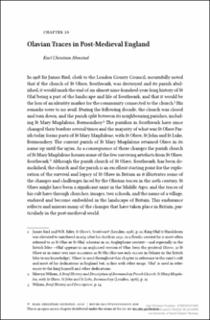| dc.description.abstract | In 1918 Sir James Bird, clerk to the London County Council, mournfully noted that if the church of St Olave, Southwark, was destroyed and its parish abolished, it would mark the end of an almost nine-hundred-year-long history of St Olaf being a part of the landscape and life of Southwark, and that it would be the loss of an identity marker for the community connected to the church.1 His remarks were to no avail. During the following decade, the church was closed and torn down, and the parish split between its neighbouring parishes, including St Mary Magdalene, Bermondsey.2 The parishes in Southwark have since changed their borders several times and the majority of what was St Olave Parish today forms parts of St Mary Magdalene, with St Olave, St John and St Luke, Bermondsey. The current parish of St Mary Magdalene retained Olave in its name up until the 1970s. As a consequence of these changes the parish church of St Mary Magdalene houses some of the few surviving artefacts from St Olave, Southwark.3 Although the parish church of St Olave, Southwark, has been demolished, the church and the parish is an excellent starting point for the exploration of the survival and legacy of St Olave in Britain as it illustrates some of the changes and challenges faced by the Olavian traces in the 20th century. St Olave might have been a significant saint in the Middle Ages, and the traces of his cult have through churches, images, two schools, and the name of a village, endured and become embedded in the landscape of Britain. This endurance reflects and mirrors many of the changes that have taken place in Britain, particularly in the post-medieval world. | en_US |

